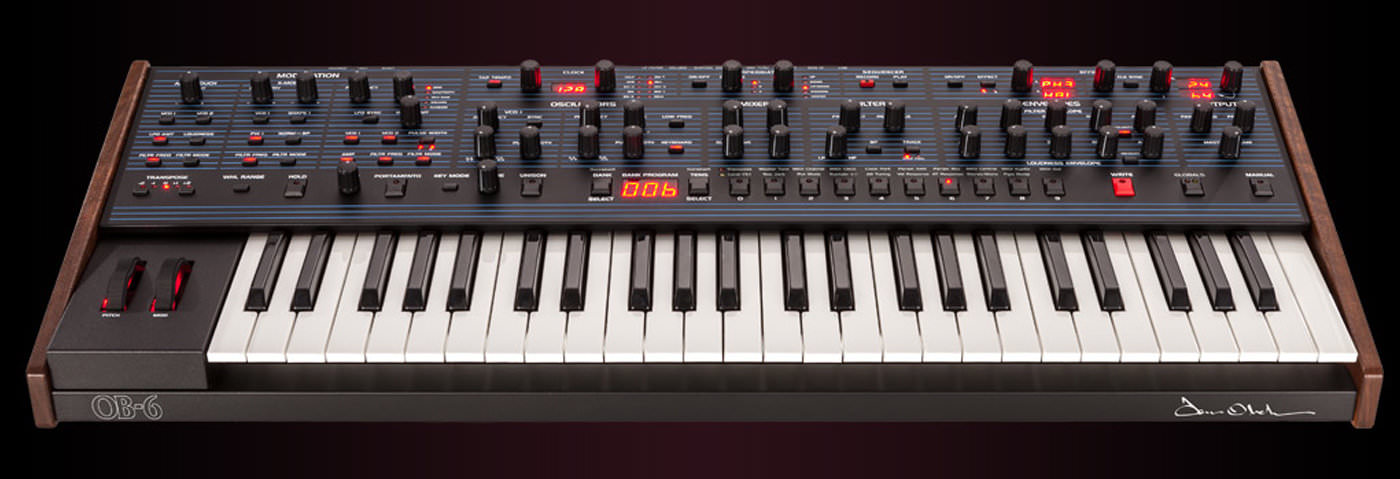Thomas Cox explores the wonderful world of modern electronic instruments.
What a time to be alive for electronic musicians! Hot on the heels of the wildly successful vintage instruments of yesteryear – such as the Roland TR-8 and the Korg Volca series – this year’s NAMM show was chock full of even more products, the likes of which have never been seen before. Korg’s new Minilogue was only released a couple of weeks ago, but it already looks positively old-fashioned compared to the latest announcements. While there are more new products than any one site could ever fully cover, here are just a few examples of the truly state-of-the-art equipment you will soon be purchasing…
On the synthesiser front, an early choice for most innovative is Arturia’s MatrixBrute. The Matrix name comes from what is described as a “modulation matrix”, which works kind of like a better version of the old-fashioned soft synths of the 1990s, allowing routing possibilities that will blow your mind. Move over, Massive! Arturia have already gone on record, calling it the most powerful analogue synth ever created. That’s quite a boast considering some of the amazing instruments we’ve seen since 2012, when Arturia themselves released the world’s first analogue synth, the MiniBrute. Even so, it sure does seem justified by the appearance of this behemoth.
Clavia has announced the Nord Piano 3, which is like a piano except two better.
Dave Smith of DSI and his new brand Sequential Circuits also had a big analogue synth announcement. Working in tandem with some guy called Tom Oberheim, Smith will be releasing a six-voice polysynth called the OB-6. This Tom guy must really be something if Dave Smith is willing to put his reputation on the line to work with him.
Other innovative new designs include a crazy thing called a Mellotron Micro which uses the latest digital technology to create the kind of lush textures that musicians of the past could only have dreamed of. Clavia has also announced the Nord Piano 3, which is like a piano except two better.
Modular continues to be the leader in new technologies. Roland is compiling their System-500 modules into one unit, in a package they are calling System-500 Complete. This will buck the current trend of buying modular synths module by module, instead coming complete as a functional synth, ready to use right out of the box. Waldorf has gone one further, combining a keyboard with a modular synth to create a kind of all-in-one synthesiser unit. One of their new modules even includes a new type of “wavetable” oscillator, which allows you to create high-tech digital recreations of analogue waveforms.
Possibly the craziest filter module comes from Rossum Electro Music, who have debuted something called the Morpheus, a “stereo morphing Z-plane filter”. I’ve not been able to locate anyone who can tell me what all of that means, but a reliable source tells me that it should turn the world of drum and bass on its head.
Even the methods of control are changing and moving into uncharted territories. Gone are the old-fashioned five-pin MIDI connectors, banished to obscurity forever. Most companies have moved to sending MIDI over USB, using a cable that modern musicians might actually own to charge their phones, as opposed to some old nonsense their grandfather might have used. The real trendsetting is being done in the field of CV, or control voltage. Many more companies are bravely stepping forward to integrate this new control system into their products. Boasting a quicker response time than MIDI, CV is sure to take over the world as musicians are finally able to get a taste of that rock-solid timing that they all desire. Arturia’s Keystep boasts CV output as well as a built-in sequencer that allows the musician using it to step completely away from the dated DAW/computer combo, while Roland’s A-01 controller allows musicians who still insist on using a laptop to trigger modern instruments.
Anything that can be done on a computer will be replicated or expanded upon in a physical format, far beyond the lame 2D representations of the past.
The days of being chained down to an unreliable, fragile laptop are soon to be completely finished. Boss is now releasing something called a vocoder pedal, which will allow you to modulate a vocal with a synth sound, effectively making software like Autotune and Melodyne obsolete.
Within just a few years, computer music may cease to exist entirely as the wave of hands-on hardware eliminates the old style of in-the-box electronic music production. Anything that can be done on a computer will be replicated or expanded upon in a physical format, far beyond the lame 2D representations of the past.
The presence of modern capabilities such as keys and knobs on each piece of gear will really be convenient as the next generation of electronic musicians comes up, especially once they are exposed to something called “music lessons” in which an instructor teaches the student how to physically play an actual instrument, as well as the “theory” behind playing it. Even better, the resulting compositions can now be released on the hottest new format, vinyl records. The sky is truly the limit!
Thomas Cox has been causing trouble on teh interwebs since 1996 and representing Pittsburgh, Pennsylvania since birth. You can find him on Twitter
.


09.28 PM
“That’s quite a boast considering some of the amazing instruments we’ve seen since 2012, when Arturia themselves released the world’s first analogue synth, the MiniBrute.”
“Dave Smith of DSI and his new brand Sequential Circuits”
????????????????????
10.08 PM
Obviously this whole column is sarcastic. But isn’t NAMM a trade show for retail shops and distributors? Of course it will be skewed towards more “safe” hardware products.
12.10 AM
Bravo!
12.11 AM
I, for one, welcome our new miniature-fingered overlords.
12.39 AM
Thomas Cox you are a huge hack. Your articles are the most tedious, high-handed drivel I have the displeasure of reading on a semi-regular (thank god) basis. It’s a shame that Attack feel the need to resort to publishing adversarial click-bait bullshit in order to get readers.
07.34 PM
This would be a lot better if it was funny
12.47 AM
i agree with the article. Dance music has become incredibly conservative and the ways which dance music is produced reflect that. Analog fetishm has reached crazy levels just check out the prices on eBay. But what the article doesn’t address is laptop and plug ins haven’t produced a new surge in creativity or new musical advances. Bad Time stretched disco edits and maybe dub step? It’s just made it easier and cheaper for people to make music which is why there is so much crap out there. I like the idea that people are spending money on hardware instead of stealing plugins and think the music sounds better for it.
04.12 PM
This article presupposes (as most of Attack Magazine) that creativity in (dance) music has a direct cause in the endless development of “innovative” music gear, hardware or software. A brief look into the last 30 years of electronic dance music should quickly establish that this is hardly the way “innovation” works.
The most “innovative” dance music in the last 5-10 years has come from people outside established “scenes” and that is the main reason, not because of the gear used.
Also, the article was not very funny.
06.08 PM
Excelent article. Thanks Thomas for speaking what should be spoken.
08.55 PM
Oooh so edgy! Good job Thomas! ????
11.31 PM
hm nope. fail. big fail. big wanna be troll fail.